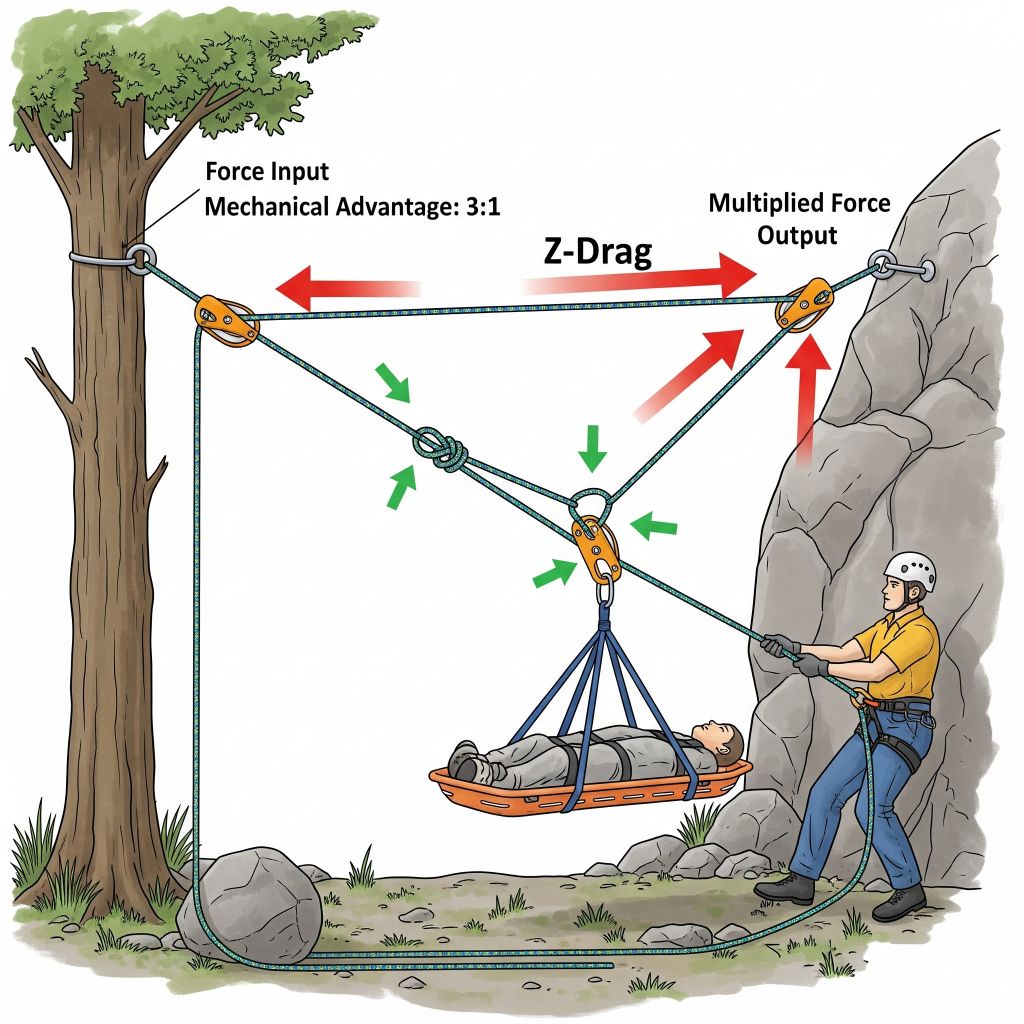
Have you ever wondered what a Z-Drag is and how it actually works? Well, I’m here to break it down for you in simple terms. Whether you’re a seasoned kayaker or just starting out, understanding the mechanics of a Z-Drag can be a game-changer in tricky situations on the water.
Picture this: you’re out on a river adventure and suddenly find yourself needing to rescue a friend or retrieve a stuck kayak. That’s where the Z-Drag technique comes into play. It’s a powerful mechanical advantage system that allows you to efficiently pull heavy loads with minimal effort. Stay tuned as I dive deeper into the intricacies of Z-Drag and how you can master this essential skill for your next paddling escapade.
Key Takeaways
- A Z-Drag is an essential mechanical advantage system used in rescue missions for efficient load hauling in kayaking scenarios.
- Components of a Z-Drag system include the main line, anchor, pulleys, Prusik loops, carabiners, and safety backup for optimal functionality.
- Setting up a Z-Drag involves anchoring, attaching the main line, configuring pulleys, installing Prusik loops, placing carabiners, and incorporating a safety backup.
- The Z-Drag works by distributing load across the system using pulleys, Prusik loops, carabiners, and safety backups to move objects effectively during rescues.
- Tips for using Z-Drag effectively include practicing, checking equipment, clear communication, being adaptable, prioritizing safety, aiming for efficiency, and continuous training.
What is a Z-Drag?
A Z-Drag is an essential mechanical advantage system used by kayakers for efficient load hauling during rescue missions. It involves a series of pulleys and ropes configured in a specific way to multiply the force applied when pulling heavy objects or individuals out of the water.
When a paddler encounters a situation requiring significant strength to rescue a fellow kayaker or retrieve gear, mastering the Z-Drag technique can make a substantial difference. By setting up the pulley system correctly, I can utilize the laws of physics to my advantage, making it easier to execute challenging rescues in a safe and effective manner.
The Z-Drag system derives its name from the shape formed by the ropes when set up correctly, resembling the letter “Z.” This setup allows me to apply force in a way that maximizes efficiency and minimizes the energy expended, crucial factors in emergency scenarios on the water where every moment counts.
By understanding how a Z-Drag works and practicing its implementation, I can enhance my rescue skills and be better prepared to handle unexpected challenges while kayaking.
Components of a Z-Drag System
When assembling a Z-Drag system, there are several key components that come together to maximize its efficiency and effectiveness in rescue operations. Here are the essential elements:
- Main Line: This is the primary rope that connects to the load being pulled. It bears the brunt of the weight and tension during the rescue process.
- Anchor: A secure anchor point is crucial for the stability and safety of the entire system. It provides the necessary foundation for the Z-Drag to function optimally.
- Pulleys: Pulleys play a critical role in multiplying force and redirecting the pull in the desired direction. They enhance the mechanical advantage of the system.
- Prusik Loops: These friction hitches are used to create progress capture within the system. They prevent the load from slipping back when the tension is released.
- Carabiners: Carabiners are used for connecting various components of the Z-Drag system together, creating a cohesive and reliable setup.
- Safety Backup: Including a safety backup in the form of a separate line or anchor adds an extra layer of protection in case of system failure.
By understanding the function and significance of each component, kayakers can build a robust Z-Drag system that is ready to handle challenging rescue situations with precision and efficiency.
Setting Up a Z-Drag
When setting up a Z-Drag, it’s crucial to follow a systematic approach to ensure a reliable and effective system. Here’s how I typically go about setting up a Z-Drag for a seamless rescue operation:
- Anchor Placement: Securely anchor the system to a stable object like a tree or rock using a reliable anchor sling.
- Main Line Attachment: Connect the main line to the kayak requiring rescue, ensuring a strong attachment point.
- Pulleys Configuration: Position the pulleys along the main line, creating the necessary mechanical advantage for the rescue operation.
- Prusik Loops Installation: Install Prusik loops above the pulleys to prevent slippage and provide additional control over the system.
- Carabiner Placement: Attach carabiners at key points to link components securely and enable smooth movement within the system.
- Safety Backup: Always incorporate a safety backup, such as a separate line or additional anchors, to enhance the reliability of the Z-Drag system.
By methodically setting up each component of the Z-Drag system with precision and attention to detail, I can ensure a robust and efficient setup ready to tackle challenging rescue scenarios with confidence.
How Does a Z-Drag Work?
A Z-Drag is a mechanical advantage system designed to make it easier to rescue a stuck or pinned object. It works by distributing the load of the object – in this case, a kayak or a person in a swiftwater rescue scenario – across multiple points in the system.
Here’s a breakdown of how a Z-Drag functions:
- Pulleys: By incorporating pulleys into the system, the force required to move the object is reduced. Each additional pulley increases the mechanical advantage, making it easier to pull the object free.
- Prusik Loops: These loops are attached to the main line and anchor point, providing a way to control the movement of the load. They prevent slippage and ensure precise management of the rescue operation.
- Carabiners: Strategically placed carabiners help create additional attachment points and facilitate smooth movement of the main line through the system.
- Safety Backup: Including a safety backup – such as a separate line or friction hitch – is crucial to mitigate risks of system failure and ensure a safe rescue operation.
In essence, a Z-Drag works by utilizing these components to multiply the force applied to the system, making it possible to move heavy or immovable objects with relative ease in a rescue scenario.
Tips for Using Z-Drag Effectively
When utilizing a Z-Drag, certain tips can help ensure a successful rescue operation:
- Practice: Before facing a real rescue scenario, practice setting up and using a Z-Drag system. Familiarity is key to efficiency in emergencies.
- Check Equipment: Inspect all components regularly for wear and tear. A well-maintained system is crucial for its effectiveness.
- Communication: Establish clear communication with your team members. Everyone should understand their roles and responsibilities during the rescue.
- Adjustment: Be ready to adjust the setup if needed. Flexibility and adaptability are essential in dynamic rescue situations.
- Safety First: Always prioritize safety. Double-check connections, knots, and anchor points to prevent accidents during the operation.
- Efficiency: Strive for efficiency in your movements. Smooth and coordinated actions can make a significant difference in the success of the rescue effort.
- Training: Continuous training and skill development are vital. Stay updated on the latest techniques and best practices in swiftwater rescue operations.
By following these tips, rescuers can enhance their proficiency in using a Z-Drag effectively during emergencies.
Conclusion
Implementing a Z-Drag system is crucial for successful swiftwater rescues. By utilizing pulleys, Prusik loops, and carabiners, rescuers can efficiently distribute the load and increase the applied force. Remember to prioritize safety, practice setup, and maintain equipment regularly. Clear communication, adaptability, and efficiency are key when utilizing a Z-Drag. Continuous training is essential to enhance proficiency in swiftwater rescue operations. Stay prepared, stay safe, and be ready to tackle any challenging rescue scenarios with confidence using the Z-Drag system.
Frequently Asked Questions
Q: What is a Z-Drag system?
A: A Z-Drag system is a mechanical advantage setup used in swiftwater rescues to retrieve stuck or pinned objects with increased leverage and force distribution.
Q: What are the key components of a Z-Drag system?
A: Key components include pulleys, Prusik loops, carabiners, and safety backups to create a rigging system that multiplies force and aids in efficient rescues.
Q: How can I use a Z-Drag effectively?
A: Practice setting up the system, regularly inspect your gear, maintain clear communication, prioritize safety, aim for efficiency, be adaptable, and continually train for proficiency in swiftwater rescue operations.
